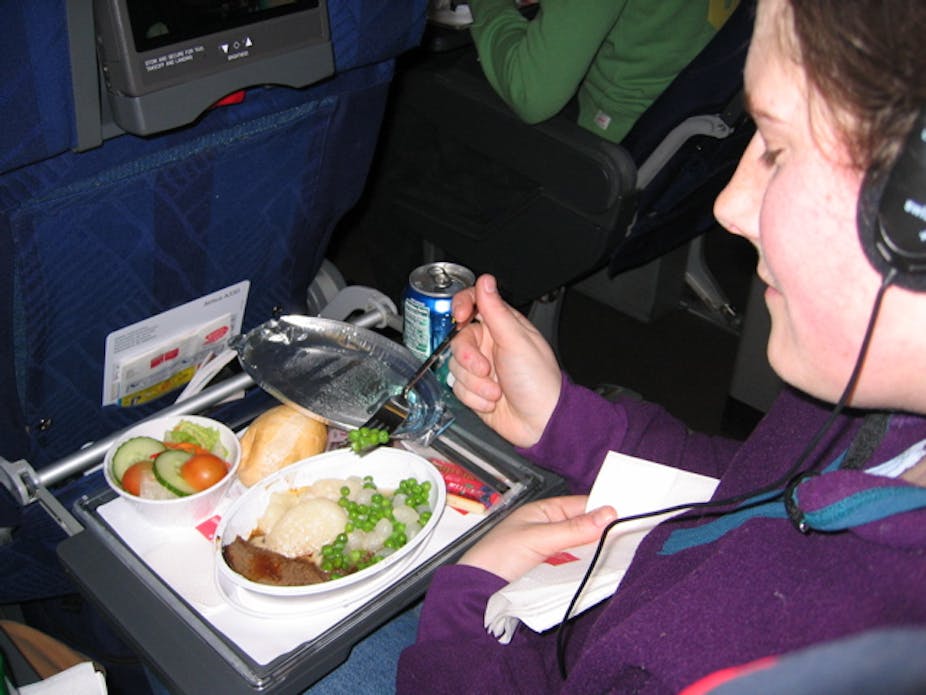Many people find being high up an unpleasant experience. This is not just mountain sickness or acrophobia – it turns out our taste buds too have no head for heights.
Taste is not just determined by the gustatory qualities of the food. It is also substantially influenced by the state of your mouth. Transient changes in our sense of taste are quite common.
This can occur with gum and dental disease and mouth problems such as thrush and mucositis associated with a cold/flu or chemotherapy. Some medications can also alter taste sensation including some anti-hypertensive drugs, antibiotics and antihistamines.
Contaminated pine nuts may also trigger a persistent unpleasant taste, known as pine mouth.
Low zinc levels can also alter our sense of taste. Most Australians don’t receive their recommended daily intake (RDI) of zinc. This can be a particular problem as, unlike iron and other trace metals we need for health, we don’t store zinc in our bodies, so we need a daily fix to maintain healthy levels.
The best dietary sources of zinc are crustaceans, meat and poultry. Many cereals and other products are now fortified with zinc. Zinc is also present in many nutritional supplements and multivitamins.
Strict vegetarians are at increased risk of low zinc levels, partly as they avoid zinc-rich meat and partly as fibre in plants reduces zinc absorption. Alcoholics and those with digestive diseases are also more likely to become zinc-deficient.
Changing tastes
So what about the food served on a plane? Actually, there may really be a reason why meals doesn’t taste any good at altitude (beyond the fact you are flying cattle class).
As most commercial flights go up, the atmospheric pressure is slowly reduced, on average, to the equivalent of standing on the summit of Mount Kosciuszko (2,228 metres or 7,310 feet above sea level).
That’s why ear-popping occurs on take-off, as air within the middle ear expands, builds up pressure and eventually pops out through the Eustachian tubes into the nose.
Newer aircraft, such as the Airbus A380, keep a lower cabin pressure (1,500 metres), equivalent to standing at Falls Creek, Victoria, at about 1,780 metres.
It is well known that reduced atmospheric pressure and lower oxygen levels dull the appetite. But even the modest changes in altitude associated with plane travel may be sufficient to change sensitivity for some tastes.
One small study showed that the threshold for tasting sweet or salty tasting substances increased when you go from sea level to 3,500 metres, while thresholds for sour and bitter went down. In other words, really sweet things didn’t taste so bad, but slightly acidic or bitter things, such as a sauvignon blanc or coffee, tasted a whole lot worse.
High and dry
The dry atmosphere inside a plane’s cabin also dries out the mouth. Typically relative humidity is very low at less than 10%. The only place on the ground that gets this low is in Death Valley, California. By comparison, average humidity in the Sahara Desert is about 25%.
Although most people notice dry, sore eyes and dry, itchy skin after long flights, progressive drying of the nose and mouth also occurs, producing an unpleasant “pastie” sensation (much like cotton in the mouth).
In particular, saliva reduces its water content to become more concentrated and more viscous. This can leave a salty taste in the mouth and affect the level at which salt can be tasted in food. An increased concentration of glutamate (which naturally occurs in saliva) can also produce an unpleasant taste.
More importantly, taste in food is a function of its solubility in saliva. Taste molecules must dissolve in the salivary fluid layer to reach and stimulate taste receptors.
Again, a dry mouth makes this more difficult for some tastes, especially sweet and salty. At the same time the buffering capacity of saliva falls, increasing the intensity of sour tastes in food and drink.
When you are dry, almost any cold drink tastes good, even those that would be distasteful when you are well hydrated. This fact, in combination with aforementioned changes in taste sensitivity, may partly explain recently publicised reports by Lufthansa scientists that tomato juice is more popular on flights, while few people touch the stuff on the ground.
A rational response would be to serve more sweet and spicy food on planes and less astringent wine, to be as appetising as food tastes on the ground.
But because of the noise, the vibration, the cramped conditions, and re-heated mass-produced food, eating on planes won’t ever make for a pleasurable dining experience – so just keep coming round with the cold water, thanks!

